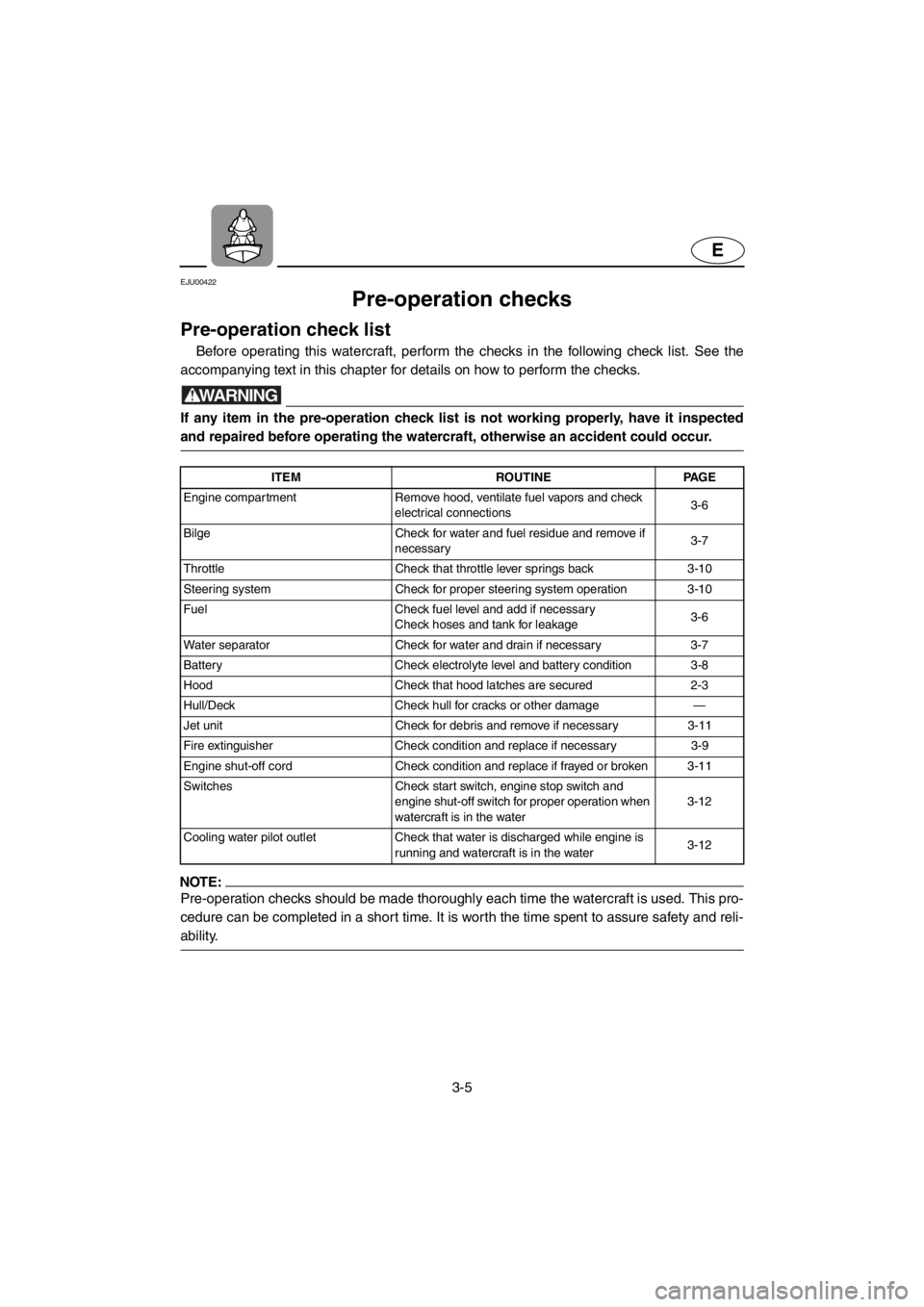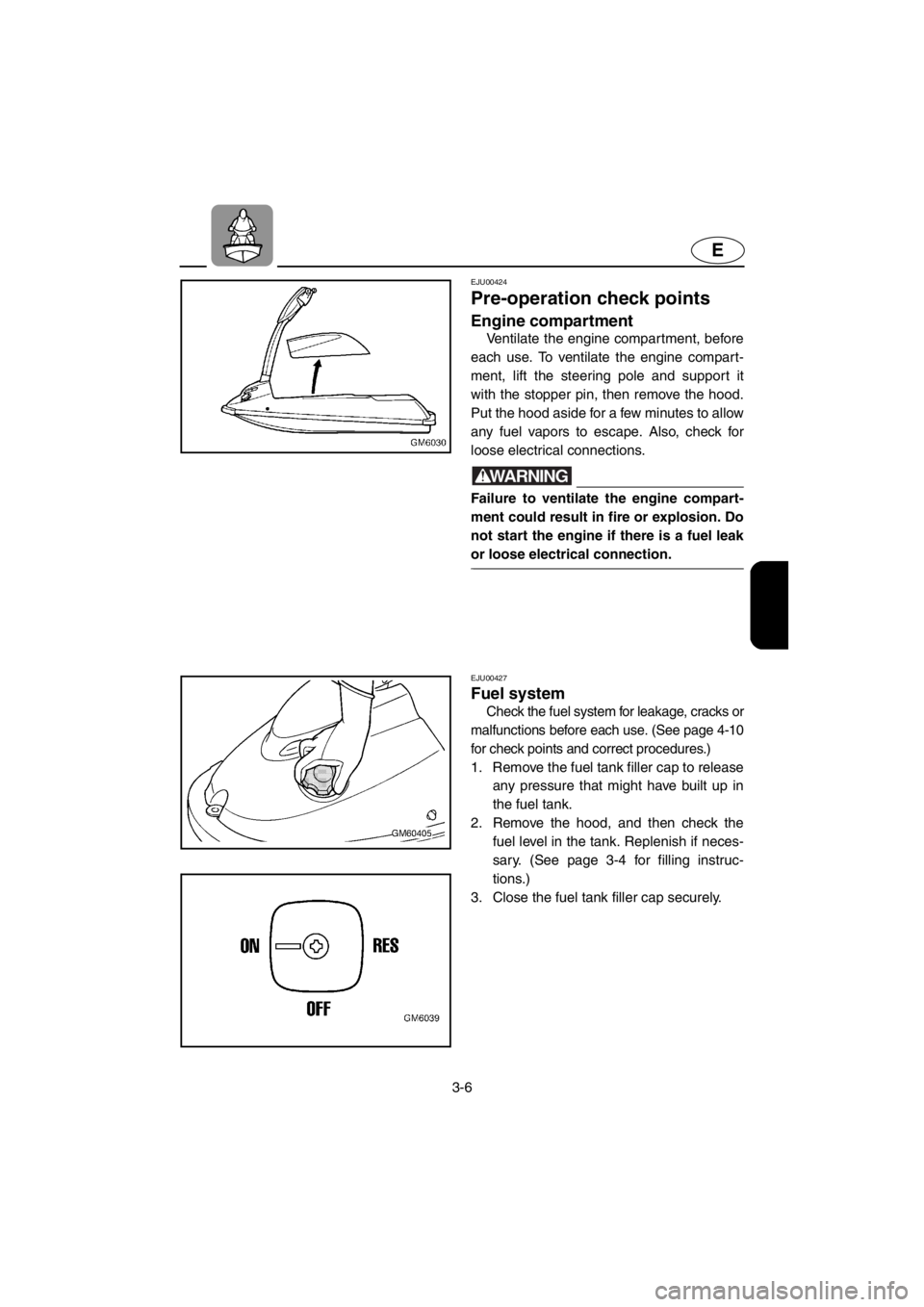Page 36 of 107

3-1
E
EJU00421
Fuel and oil
Gasoline
WARNING@GASOLINE AND ITS VAPORS ARE
HIGHLY FLAMMABLE AND EXPLOSIVE!
●Do not smoke when refueling, and
keep away from sparks, flames, or
other sources of ignition.
●Stop engine before refueling.
●Refuel in a well-ventilated area. Do not
stand or sit on the watercraft while
refueling in case of fire.
●Take care not to spill gasoline. If gaso-
line spills, wipe it up immediately with
dry rags. Always properly dispose of
gasoline-soaked rags.
●Avoid overfilling the fuel tank. Stop fill-
ing when the fuel level just reaches the
bottom of the filler tube. Do not fill up
the filler tube because fuel expands as
it warms up and could overflow.
●Tighten the filler cap securely after
refueling.
●If you should swallow some gasoline,
inhale a lot of gasoline vapor, or get
gasoline in your eyes, get immediate
medical attention.
●If any gasoline spills onto your skin,
immediately wash with soap and
water. Change clothing if gasoline
spills on it.
@
CAUTION:@Use only fresh gasoline that has been
stored in clean containers.
@
Recommended gasoline:
Regular unleaded gasoline:
Minimum octane rating:
86 (Pump octane number): (R+M)/2
90 (Research octane number)
E_GM6-3.fm Page 1 Tuesday, July 11, 2000 10:52 AM
Page 37 of 107
3-2
E
Gasohol
There are two types of gasohol: gasohol
containing ethanol and that containing meth-
anol.
Gasohol containing ethanol can be used
if ethanol content does not exceed 10% and
the fuel meets minimum octane ratings.
Gasohol containing methanol is not rec-
ommended by Yamaha because it can
cause fuel system damage or engine perfor-
mance problems.
EJU00939
2-stroke engine oil
If YAMALUBE 2-W is not available,
another 2-stroke engine oil with an NMMA-
certified TC-W3 rating may be used.Recommended engine oil:
YAMALUBE 2-W
E_GM6-3.fm Page 2 Tuesday, July 11, 2000 10:52 AM
Page 38 of 107
3-3
E
Mixing fuel and oil
CAUTION:@●Avoid using any mixture of gasoline
and oil other than those designated.
●Make sure gasoline and oil are thor-
oughly mixed in the correct ratio, oth-
erwise the following problems may
occur. Too little oil in the fuel mixing
ratio could result in major engine trou-
ble, such as seizure. Too much oil in
the fuel mixing ratio could result in
fouled spark plugs, smoky exhaust, or
heavy carbon deposits.
@
Pour 2-stroke engine oil into a clean con-
tainer, and then add gasoline. To mix them
thoroughly, shake the container from side to
side.
Fuel mixing ratios
(gasoline to oil)
Break-in period
(first two tankfuls): 25 : 1
After break-in: 50 : 1
E_GM6-3.fm Page 3 Tuesday, July 11, 2000 10:52 AM
Page 39 of 107
3-4
E
Filling the fuel tank
CAUTION:@Be careful when refueling. Avoid getting
water or other contaminants in the fuel
tank. Contaminated fuel can cause poor
running or engine damage.
@
1. Lift the steering pole and support it with
the lock pin.
2. Remove the hood.
3. Open the fuel tank filler cap, and slowly
add the premixed fuel to the fuel tank.
4. Stop filling when the fuel level just
reaches the bottom of the filler tube.
NOTE:@●The hood must be removed in order to
watch the fuel level in the fuel tank while
adding fuel.
●Be careful not to spill fuel or overfill the
tank.
●Do not fill into the filler tube because fuel
could overflow.
@
Fuel tank capacity:
Total: 18 L (4.8 US gal, 4.0 Imp gal)
Reserve: 5.5 L (1.45 US gal, 1.21 Imp gal)
E_GM6-3.fm Page 4 Tuesday, July 11, 2000 10:52 AM
Page 40 of 107

3-5
E
EJU00422
Pre-operation checks
Pre-operation check list
Before operating this watercraft, perform the checks in the following check list. See the
accompanying text in this chapter for details on how to perform the checks.
WARNING@If any item in the pre-operation check list is not working properly, have it inspected
and repaired before operating the watercraft, otherwise an accident could occur.
@
NOTE:@Pre-operation checks should be made thoroughly each time the watercraft is used. This pro-
cedure can be completed in a short time. It is worth the time spent to assure safety and reli-
ability.
@
ITEM ROUTINE PAGE
Engine compar tment Remove hood, ventilate fuel vapors and check
electrical connections3-6
Bilge Check for water and fuel residue and remove if
necessary3-7
Throttle Check that throttle lever springs back 3-10
Steering system Check for proper steering system operation 3-10
Fuel Check fuel level and add if necessary
Check hoses and tank for leakage3-6
Water separator Check for water and drain if necessary 3-7
Battery Check electrolyte level and battery condition 3-8
Hood Check that hood latches are secured 2-3
Hull/Deck Check hull for cracks or other damage —
Jet unit Check for debris and remove if necessary 3-11
Fire extinguisher Check condition and replace if necessary 3-9
Engine shut-off cord Check condition and replace if frayed or broken 3-11
Switches Check start switch, engine stop switch and
engine shut-off switch for proper operation when
watercraft is in the water 3-12
Cooling water pilot outlet Check that water is discharged while engine is
running and watercraft is in the water3-12
E_GM6-3.fm Page 5 Tuesday, July 11, 2000 10:52 AM
Page 41 of 107

3-6
E
EJU00424
Pre-operation check points
Engine compartment
Ventilate the engine compartment, before
each use. To ventilate the engine compart-
ment, lift the steering pole and support it
with the stopper pin, then remove the hood.
Put the hood aside for a few minutes to allow
any fuel vapors to escape. Also, check for
loose electrical connections.
WARNING@Failure to ventilate the engine compart-
ment could result in fire or explosion. Do
not start the engine if there is a fuel leak
or loose electrical connection.
@
EJU00427
Fuel system
Check the fuel system for leakage, cracks or
malfunctions before each use. (See page 4-10
for check points and correct procedures.)
1. Remove the fuel tank filler cap to release
any pressure that might have built up in
the fuel tank.
2. Remove the hood, and then check the
fuel level in the tank. Replenish if neces-
sary. (See page 3-4 for filling instruc-
tions.)
3. Close the fuel tank filler cap securely.
E_GM6-3.fm Page 6 Tuesday, July 11, 2000 10:52 AM
Page 42 of 107
3-7
E
EJU00432
Water separator
Check the water separator 1 for water.
Normally the water separator is empty. The
water separator retains any water entering
through the fuel tank breather hose if the
watercraft capsizes.
If water remains in the water separator,
drain it by removing the drain screw 2.
Install the drain screw again after draining
the water separator.
EJU00941
Bilge
Check for moisture and fuel residue in the
bilge.
Excessive water in the bilge can splash
into the carburetor and engine which could
cause engine damage.
E_GM6-3.fm Page 7 Tuesday, July 11, 2000 10:52 AM
Page 48 of 107
3-13
E
EJU00456
Operation
WARNING@Before operating your watercraft,
become familiar with all controls. Con-
sult your Yamaha dealer about any con-
trols or functions you do not fully
understand. Failure to understand how
controls work could cause an accident or
prevent you from avoiding an accident.
@
EJU00458
Engine break-in
The engine break-in period is essential to
allow the various components of the engine
to wear and polish themselves to the correct
operating clearances. This ensures proper
performance and promotes longer compo-
nent life.
CAUTION:@●For the first 5 hours or 2 tankfuls of
operation, premix fuel and oil in a 25:1
ratio.
●After break-in, premix fuel and oil in a
50:1 ratio for normal operation.
@
1. Launch the watercraft and start the
engine, and then board the watercraft.
2. Run the engine at the lowest possible
speed for 5 minutes.
E_GM6-3.fm Page 13 Wednesday, July 12, 2000 3:01 PM